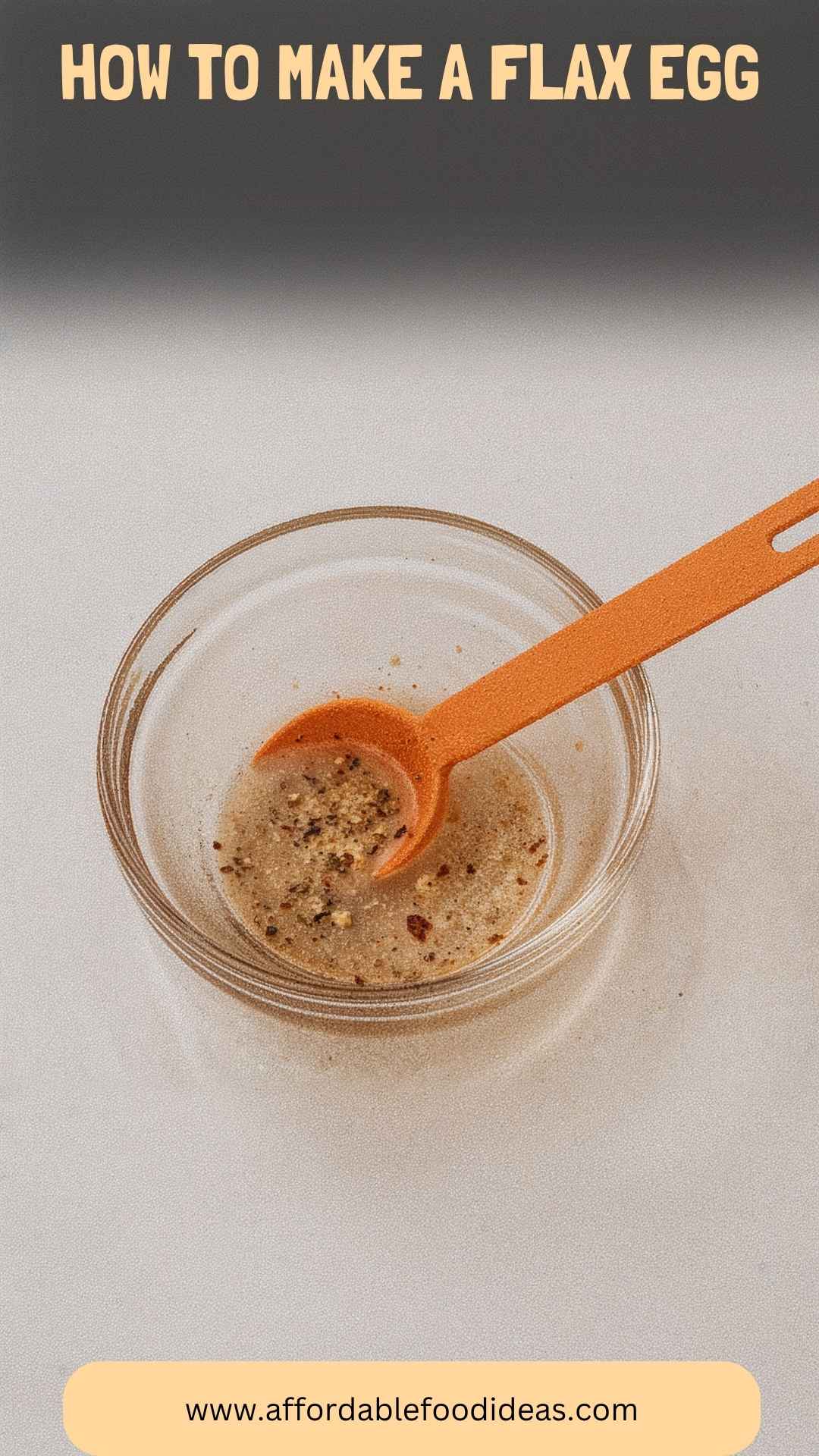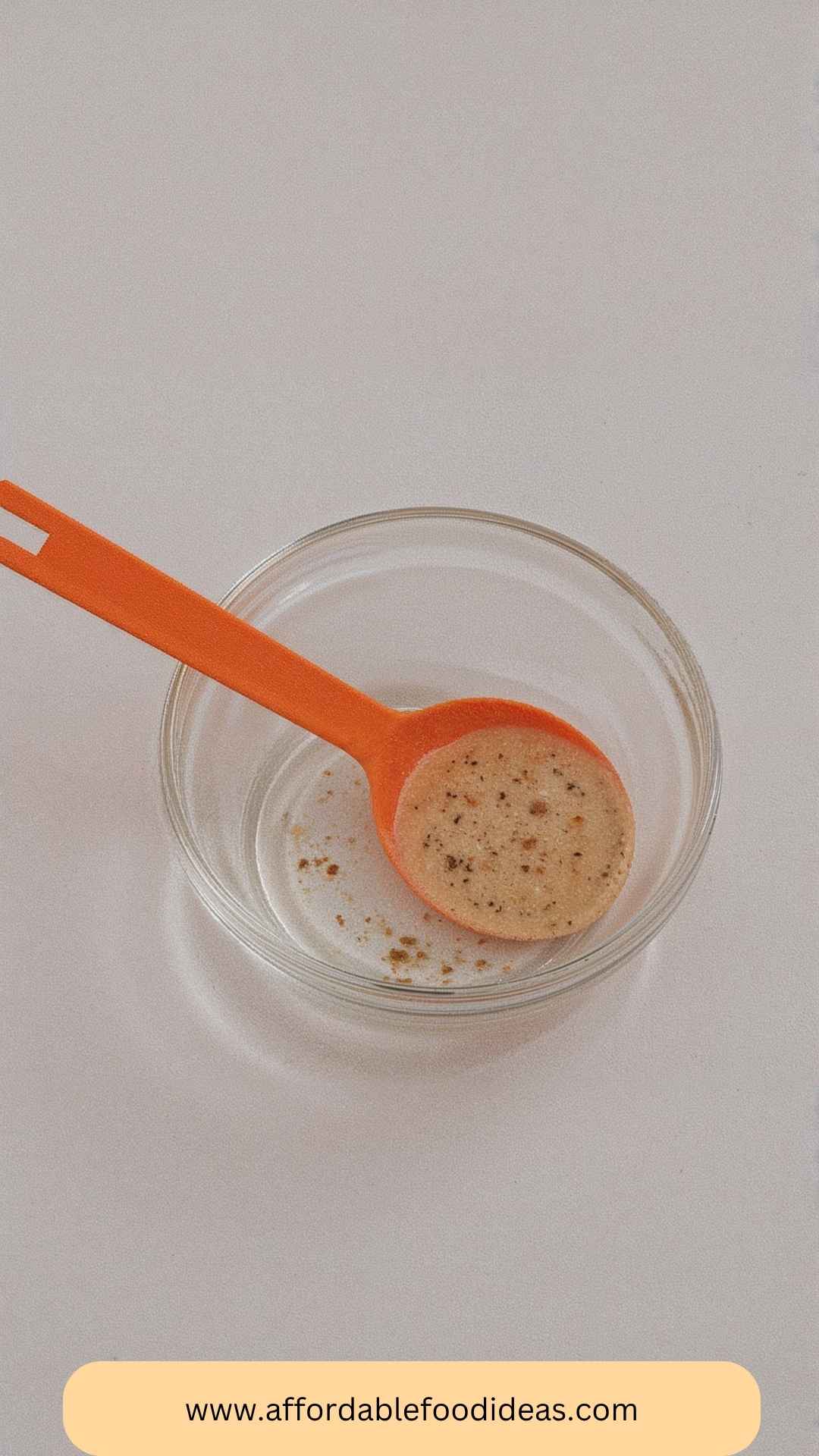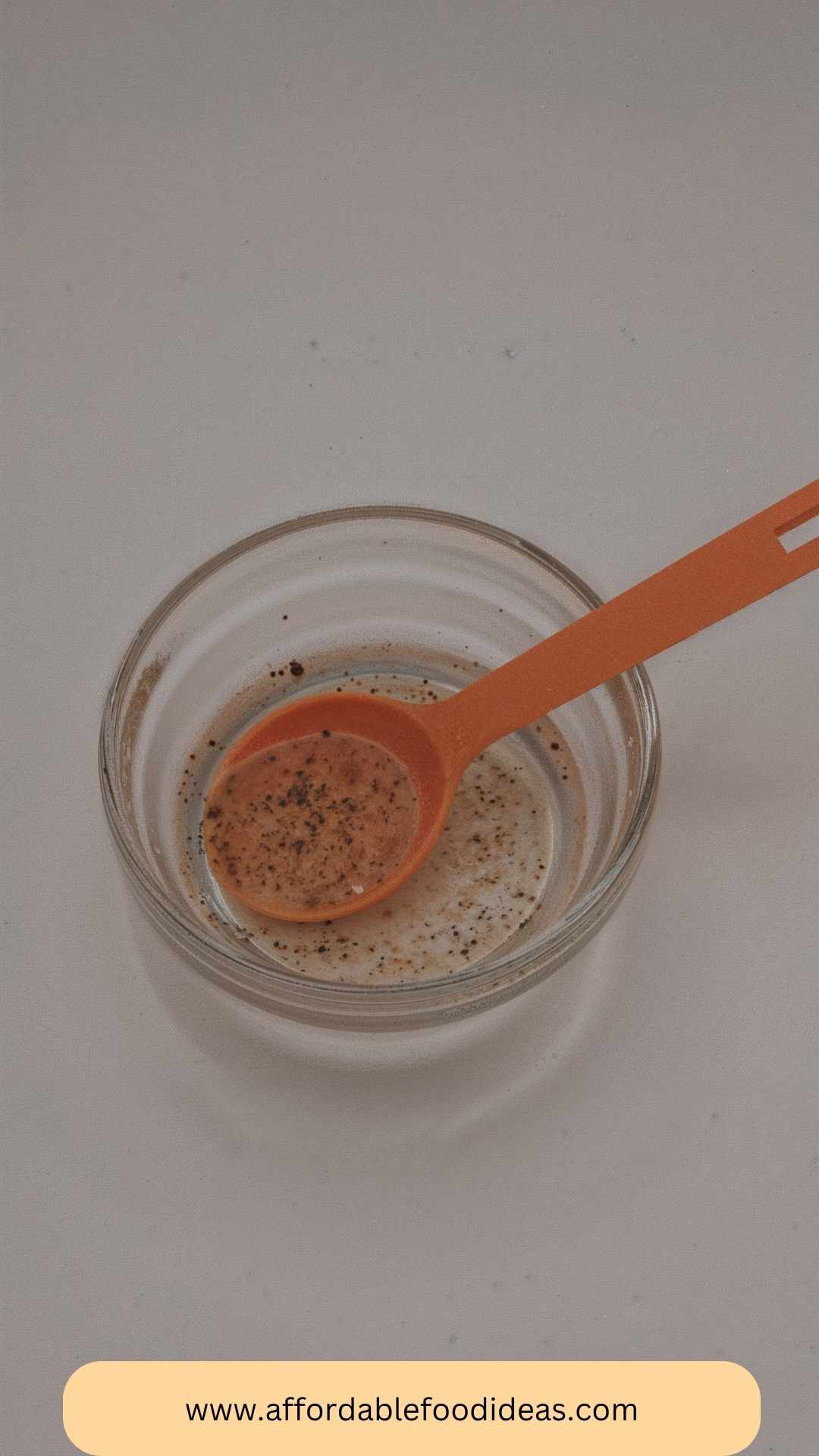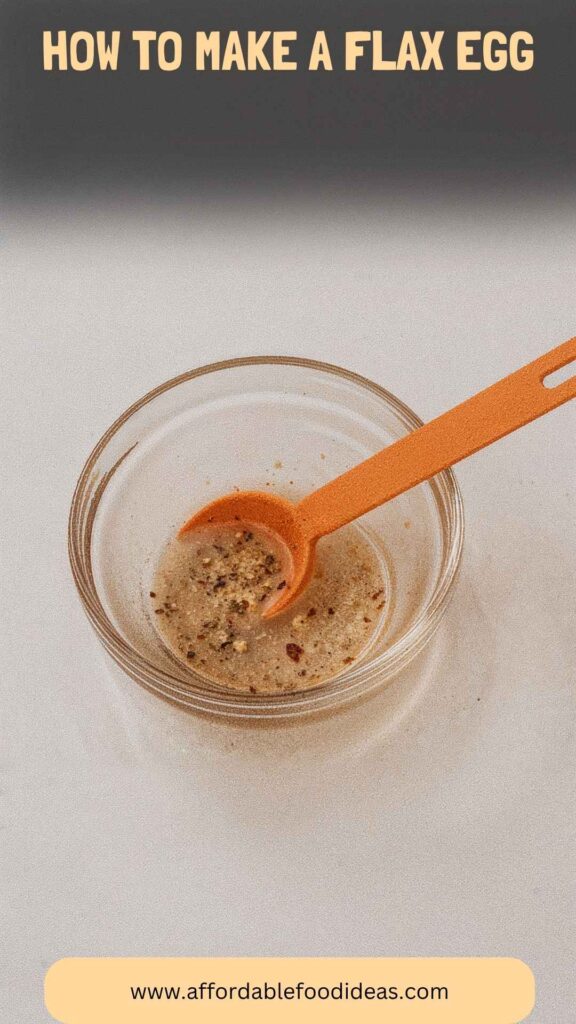Before we dive into the “how” of making a flax egg, let’s talk about what delicious dishes you can complement it with. A flax egg serves as an excellent egg substitute in various recipes, especially for those following a vegan or plant-based diet.
Think about fluffy pancakes, rich brownies, and hearty veggie burgers. Picture a savory veggie burger patty holding together beautifully, or moistened muffins that rise to perfection. Flax eggs can elevate dishes, allowing everyone to enjoy them without concern for dietary restrictions.

Ingredients Needed
Here’s what you’ll need to whip up your own flax egg:
- 2 1/2 tablespoons filtered water: Helps the flaxseed meal form a gel-like consistency.
- 1 tablespoon finely ground golden flaxseed meal: This is your key player. Made from raw flaxseeds, it acts as a brilliant substitute for eggs in many recipes.
- 1/8 teaspoon pure vanilla extract: This adds a gentle hint of flavor. Though optional, it enhances your baked goods beautifully.

How to Make a Flax Egg
Ready to mix? Follow these simple steps.
Step 1: Measure the Flaxseed Meal
Start by measuring out 1 tablespoon of finely ground golden flaxseed meal. I prefer the golden variety, as it has a milder taste than the brown flaxseed meal.
Make sure your flaxseed meal is finely ground; this ensures the best texture for your dishes. You can purchase it pre-ground or buy whole flaxseeds and grind them yourself. The latter often yields fresher results!
Step 2: Combine Ingredients
Next, grab a small bowl. Add the 1 tablespoon of flaxseed meal and then pour in the 2 1/2 tablespoons of filtered water. Stir these two together. This part is pivotal; you want to ensure the flaxseed meal is evenly distributed in the water.
Step 3: Wait for Transformation
Let the mixture sit for about 5 to 10 minutes. This waiting period is where the magic happens. You’ll notice the mixture thickens into a gel-like consistency similar to that of a beaten egg. This is your go-ahead to substitute your newly created flax egg into any recipe that calls for an egg.
Step 4: Use in Your Favorite Recipe
Now, you have a creamy, binding mixture ready to go! Use it in your baking, cooking, or even smoothies. Depending on the recipe, you can substitute in equal amounts where eggs are called for.
Recipe Notes: Understanding the Ingredients
- Flaxseed Meal: Flaxseeds are packed with nutrients. They are high in fiber, which aids digestion, and are an excellent source of plant-based omega-3 fatty acids. Flaxseed meal can also add a slightly nutty flavor to your dishes.
- Filtered Water: Opt for filtered water to ensure your flax egg is as pure as your intentions for eating healthily. Tap water may carry traces of chlorine or other compounds that could affect the flavor.
- Vanilla Extract: Adding vanilla extract can elevate the taste of your recipes significantly. It’s a simple ingredient that packs a punch without extra calories.
Recipe Variations
While this basic formula is a fantastic starting point, there are ways to mix it up.
- Chia Egg: Replace flaxseed meal with chia seeds using a similar method. Chia eggs have a slightly nutty taste and are another excellent binding agent.
- Fruit Purees: In sweet recipes, consider using unsweetened applesauce or mashed bananas as additional alternatives to flax eggs. They add moisture and a hint of sweetness.
- Nut Butters: Peanut or almond butter can also act as excellent binders, especially in cookies and bars.
- Aquafaba: The liquid from canned chickpeas, known as aquafaba, can replace eggs in many formulations. Use three tablespoons of aquafaba for each egg you are replacing.
- Silken Tofu: Blend silken tofu until smooth for a creamy substitute in recipes like brownies.
- Commercial Egg Replacers: There are many commercial egg replacers available that work well in various baking contexts.

Conclusion
Making a flax egg is a small, easy step toward healthier cooking. It provides an excellent alternative to traditional eggs, enhancing recipes without compromising flavor or nutrition. As a registered dietitian and food blogger, I’m enthusiastic about sharing tips and recipes that make healthy eating accessible and enjoyable.
So now that you have the knowledge and tools to create your flax egg, dive into the world of plant-based recipes. Whether you’re baking a decadent cake or whipping up a batch of veggie burgers, the flax egg is your new kitchen ally. Enjoy experimenting and discovering the joy of cooking with this simple yet powerful ingredient!
You’ll also like the following recipes!
How to make a Flax Egg – Affordable Food Ideas
When I first journeyed into the world of plant-based cooking, the concept of replacing eggs took me by surprise. How can something as pivotal as an egg be replaced, I wondered? After some experimentation, I stumbled upon the wonder of flax eggs.
These little gems, made simply from flaxseed meal and water, provide the binding power of traditional eggs without the cholesterol or worry about allergens. They work well in countless recipes, making them an invaluable addition to any kitchen.
This recipe is exceptional for health-conscious cooks or anyone wanting to dabble in more plant-based meals. It harnesses the power of flaxseeds, known for their omega-3 fatty acids and fiber content. Since then, I've used flax eggs in everything from cookies to soups, and I can assure you they deliver consistently impressive results.

Ingredients
Instructions
Step 1: Measure the Flaxseed Meal
-
Start by measuring out 1 tablespoon of finely ground golden flaxseed meal. I prefer the golden variety, as it has a milder taste than the brown flaxseed meal.
Make sure your flaxseed meal is finely ground; this ensures the best texture for your dishes. You can purchase it pre-ground or buy whole flaxseeds and grind them yourself. The latter often yields fresher results!
Step 2: Combine Ingredients
-
Next, grab a small bowl. Add the 1 tablespoon of flaxseed meal and then pour in the 2 1/2 tablespoons of filtered water. Stir these two together. This part is pivotal; you want to ensure the flaxseed meal is evenly distributed in the water.
Step 3: Wait for Transformation
-
Let the mixture sit for about 5 to 10 minutes. This waiting period is where the magic happens. You'll notice the mixture thickens into a gel-like consistency similar to that of a beaten egg. This is your go-ahead to substitute your newly created flax egg into any recipe that calls for an egg.
Step 4: Use in Your Favorite Recipe
-
Now, you have a creamy, binding mixture ready to go! Use it in your baking, cooking, or even smoothies. Depending on the recipe, you can substitute in equal amounts where eggs are called for.
Nutrition Facts
Servings 1
- Amount Per Serving
- Calories 6kcal
- % Daily Value *
- Total Fat 0.3g1%
- Saturated Fat 0.2g1%
- Sodium 7mg1%
- Total Carbohydrate 1g1%
- Sugars 1g
* Percent Daily Values are based on a 2,000 calorie diet. Your daily value may be higher or lower depending on your calorie needs.
Note
- Flaxseed Meal: Flaxseeds are packed with nutrients. They are high in fiber, which aids digestion, and are an excellent source of plant-based omega-3 fatty acids. Flaxseed meal can also add a slightly nutty flavor to your dishes.
- Filtered Water: Opt for filtered water to ensure your flax egg is as pure as your intentions for eating healthily. Tap water may carry traces of chlorine or other compounds that could affect the flavor.
- Vanilla Extract: Adding vanilla extract can elevate the taste of your recipes significantly. It's a simple ingredient that packs a punch without extra calories.




